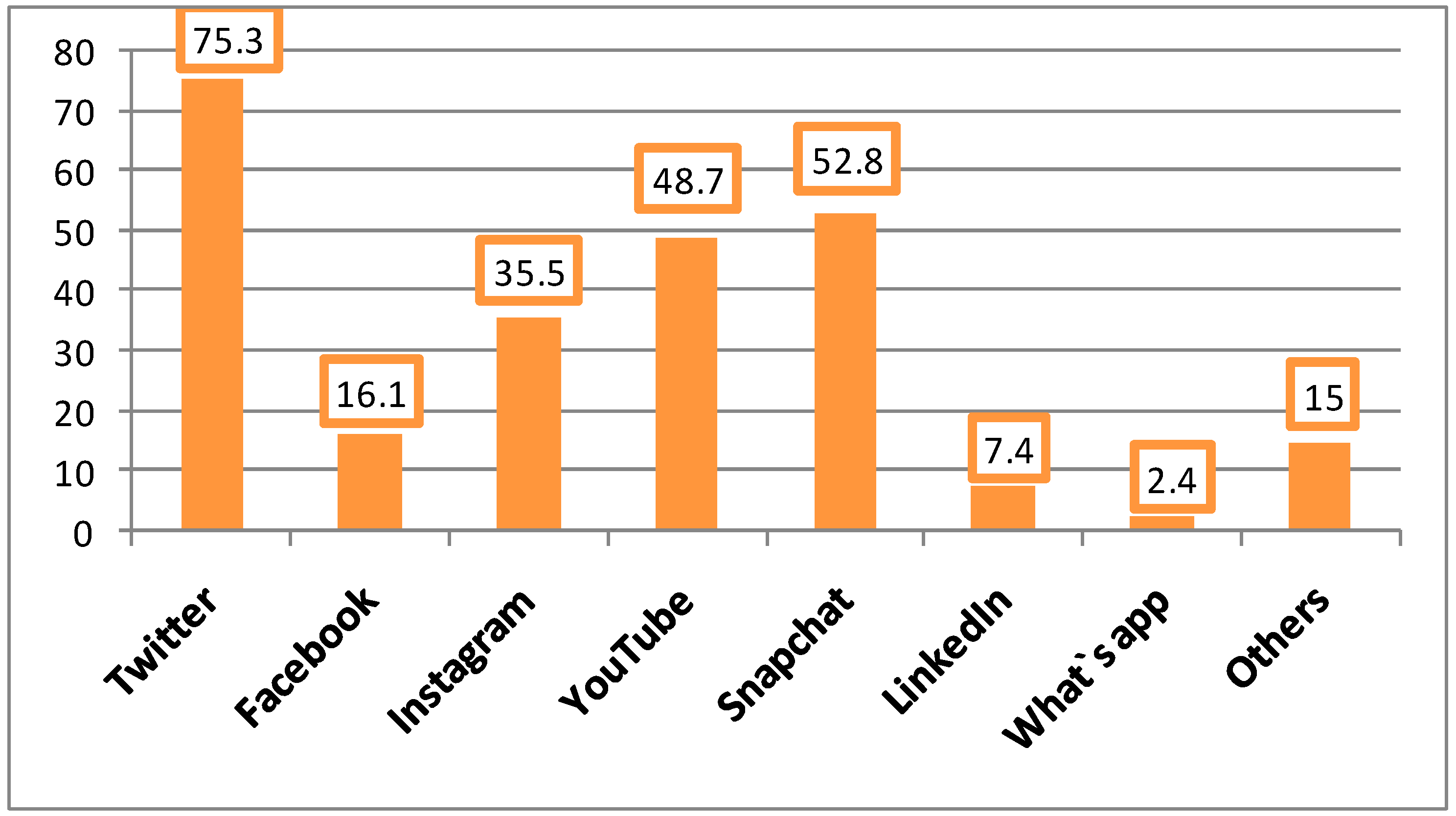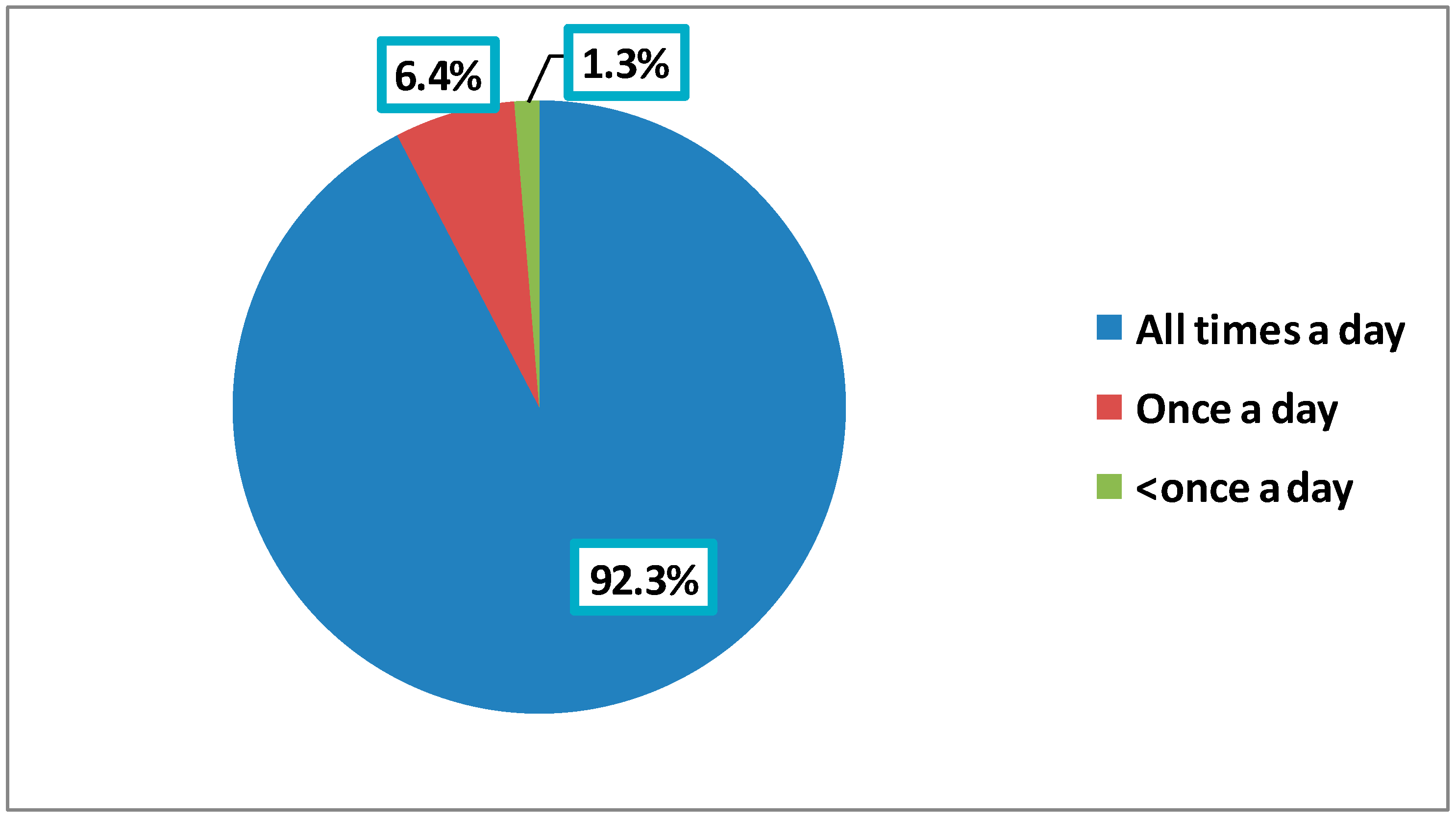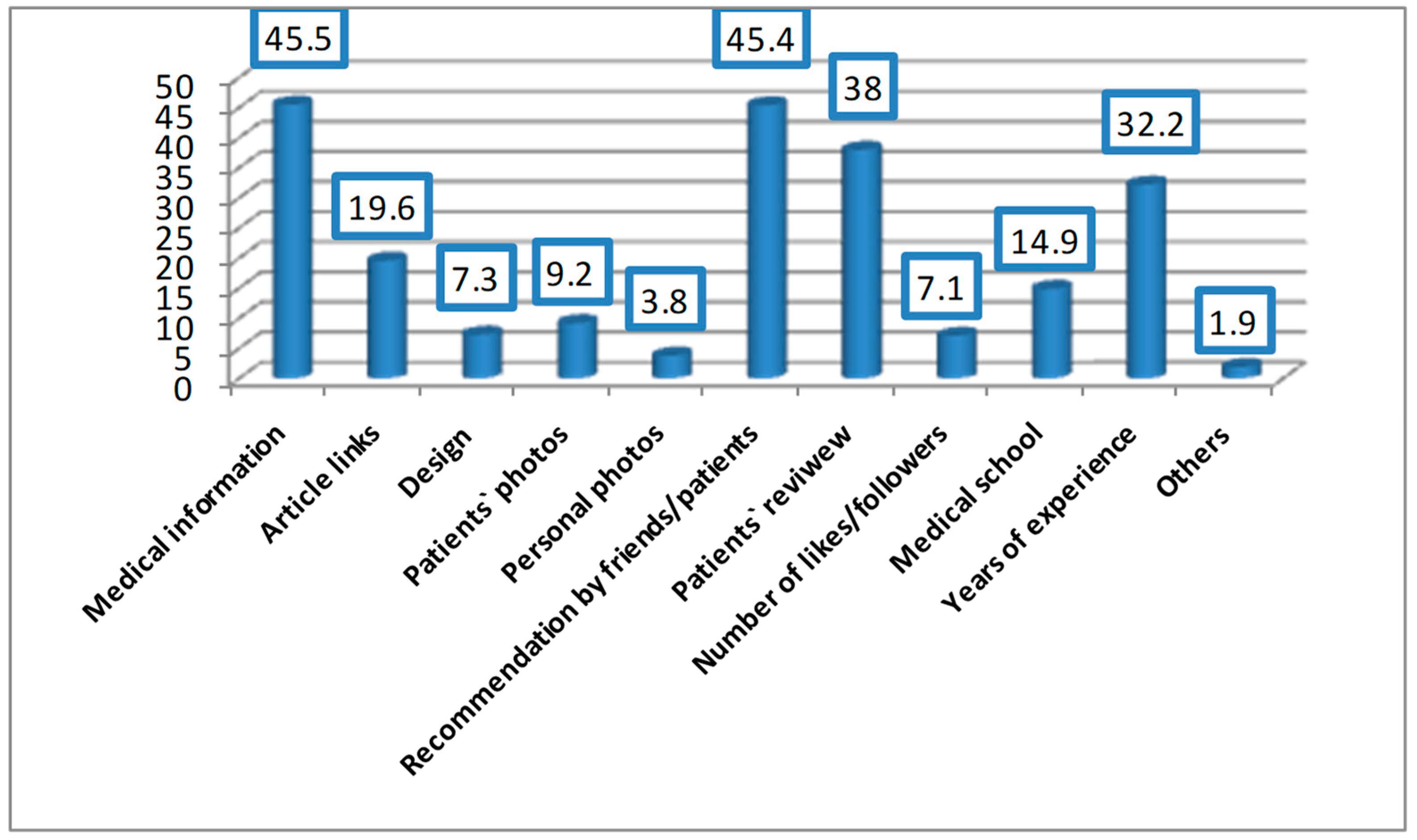Ophthalmology Practice and Social Media Influences: A Patients Based Cross-Sectional Study among Social Media Users
Abstract
1. Introduction
2. Materials and Methods
- Sample size:
- Data collection:
3. Results
4. Discussion
5. Conclusions
Author Contributions
Funding
Institutional Review Board Statement
Informed Consent Statement
Data Availability Statement
Conflicts of Interest
References
- Available online: https://wearesocial.com/blog/2019/01/digital-2019-global-internet-use-accelerates#:~:text=There%20are%203.48%20billion%20social,of%20more%20than%2010%20percent (accessed on 20 November 2020).
- Tsui, E.; Rao, R.C.; Carey, A.R.; Feng, M.T.; Provencher, L.M. Using Social Media to Disseminate Ophthalmic Information during the #COVID19 Pandemic. Ophthalmology 2020, 127, e75–e78. [Google Scholar] [CrossRef] [PubMed]
- Schmuter, G.; Tooley, A.A.; Chen, R.W.; Law, J.C. Social Media in Ophthalmology: The Educational and Professional Potential for Medical Students. J. Acad. Ophthalmol. 2020, 12, e41–e45. [Google Scholar] [CrossRef]
- Parrish, R.K.; Stewart, M.W.; Powers, S.L.D. Ophthalmologists are more than eye doctors—In Memoriam Li Wenliang. Am. J. Ophthalmol. 2020, 213, A1–A2. [Google Scholar] [CrossRef] [PubMed]
- Nathaniel, G.I.; Adio, O. How ophthalmologists and ophthalmologists-in-training in Nigeria use social media. Niger. J. Med. 2016, 25, 254. [Google Scholar] [PubMed]
- Moura-Coelho, N. The role of social media in ophthalmology: A narrative review. Ophtha Ther. 2020, 7, 262–266. [Google Scholar] [CrossRef]
- Courtney, K. The use of social media in healthcare: Organizational, clinical, and patient perspectives. Stud. Health Technol. Inform. 2013, 183, 244–248. [Google Scholar]
- Murphy, E.C.; Nelson, K.; Friedman, A.J. The Influence of Dermatologists’ Use of Social Media on Attracting Patients. J. Drugs Dermatol. 2020, 19, 532–538. [Google Scholar] [CrossRef] [PubMed]
- Micieli, J.A.; Tsui, E. Ophthalmology on social networking sites: An observational study of Facebook, Twitter, and LinkedIn. Clin. Ophthalmol. 2015, 9, 285–290. [Google Scholar] [CrossRef] [PubMed] [PubMed Central][Green Version]
- Tsui, E.; Rao, R.C. Navigating social media in# ophthalmology. Ophthalmology 2019, 126, 779–782. [Google Scholar] [PubMed]
- Ting, D.S.; Peng, L.; Varadarajan, A.V.; Keane, P.A.; Burlina, P.M.; Chiang, M.F.; Schmettererahij, L.; Pasqualek, L.R.; Bressler, N.M.; Webster, D.R.; et al. Deep learning in ophthalmology: The technical and clinical considerations. Prog. Retin. Eye Res. 2019, 72, 100759. [Google Scholar] [CrossRef] [PubMed]
- Thanuskodi, S.; Thanuskodi, S. Usage of Electronic Resources among Ophthalmologists. 2017. Library Philosophy and Practice (e-journal). Winter Volume. p. 1491. Available online: http://digitalcommons.unl.edu/libphilprac/1491 (accessed on 20 November 2020).
- Available online: http://www.raosoft.com/samplesize.html (accessed on 20 November 2020).
- Ministry of Communication and Information Technology, Kingdom of Saudi Arabia. Facebook and Twitter Top in Number of Users, Over 18 Million Users of Social Media Programs and Applications in Saudi Arabia. 2021. Available online: https://www.mcit.gov.sa/en/media-center/news/89698 (accessed on 22 November 2020).
- Kaufman, L.B. Use Social Media to Market Your Practice. EyeNet Mag. 2016, 1–3. Available online: https://www.aao.org/eyenet/article/use-social-media-to-market-your-practice (accessed on 20 November 2020).
- Ross, N.; Todd, Q.; Saedi, N. Patient seeking behaviors and online personas: Social media’s role in cosmetic dermatology. Dermatol. Surg. 2015, 41, 269–276. [Google Scholar] [CrossRef] [PubMed]
- Kirsch, I.; Jungeblut, A.; Jenkins, L.; Kolstad, A. Adult Literacy in America: A First Look at the Findings of the National Adult Literacy Survey; National Center for Education Statistics, U.S. Department of Education: Washington, DC, USA, 1993. Available online: https://nces.ed.gov/pubsearch/pubsinfo.asp?pubid=93275 (accessed on 27 May 2019).
- Zeichner, J.; Gonzalez, N. The Impact of Social Media on Cosmetic Dermatology. Available online: https://practicaldermatology.com/series/dermtube-journal-club/the-impact-of-social-media-on-cosmetic-dermatology (accessed on 18 June 2019).




| Valid Number (Total Participants) | Frequency | Percentage | |
|---|---|---|---|
| Gender | 1077 | ||
| Male | 833 | 77.3% | |
| Female | 244 | 22.7% | |
| Age (years) | 1082 | ||
| 18–24 | 72 | 6.7% | |
| 25–34 | 227 | 21.0% | |
| 35–44 | 282 | 26.0% | |
| 45–54 | 263 | 24.3% | |
| 55–64 | 182 | 16.8% | |
| ≥65 | 56 | 5.2% | |
| Highest qualification/degree | 1083 | ||
| High school | 196 | 18.1% | |
| Diploma | 132 | 12.2% | |
| Bachelor’s | 581 | 53.7% | |
| Master’s | 125 | 11.5% | |
| Doctorate/Ph.D. | 49 | 4.5% | |
| Place of residence | 1082 | ||
| Riyadh | 153 | 14.1% | |
| Mecca | 335 | 31.0% | |
| Eastern province | 93 | 8.6% | |
| Medina | 282 | 26.1% | |
| Hail | 56 | 5.2% | |
| Jazan | 53 | 4.9% | |
| Qassim | 39 | 3.6% | |
| Asir | 18 | 1.7% | |
| Tabuk | 21 | 1.9% | |
| Jawf | 16 | 1.5% | |
| Others | 16 | 1.5% |
| Valid Number | Frequency | Percentage | |
|---|---|---|---|
| Frequency of using social media | 1084 | ||
| All times of day | 1001 | 92.3 | |
| Once a day | 69 | 6.4 | |
| <Once a day | 14 | 1.3 | |
| Importance of an ophthalmologist’s social media site in a patient’s decision to be seen by them | 1080 | ||
| Not at all important | 290 | 26.9 | |
| Slightly important | 186 | 17.2 | |
| Moderately important | 212 | 19.6 | |
| Very important | 201 | 18.6 | |
| Extremely important | 191 | 17.7 | |
| Did the ophthalmologist meet patients’ expectations based on his or her social media site? | 792 | ||
| Not at all | 85 | 10.7 | |
| Slightly | 102 | 12.9 | |
| Somewhat | 217 | 27.4 | |
| Mostly | 268 | 33.8 | |
| Completely | 120 | 15.2 |
| Frequency | Percentage | |
|---|---|---|
| Refractive surgery | 206 | 19.1 |
| Routine visit | 432 | 39.9 |
| Follow-up visit | 109 | 10.1 |
| Urgent case | 276 | 25.6 |
| Never visit | 54 | 5.3 |
| Perceived Importance of Ophthalmologist’s Social Media Sites | p-Value | |||||
|---|---|---|---|---|---|---|
| Not at All Important | Slightly Important | Moderately Important | Very Important | Extremely Important | ||
| N = 255 | N = 177 | N = 209 | N = 195 | N = 185 | ||
| N (%) | N (%) | N (%) | N (%) | N (%) | ||
| Visit reason (n = 1021) | ||||||
| Refractive surgery (n = 206) | 45 (21.8%) | 35 (17.0%) | 40 (19.4%) | 40 (19.4%) | 46 (22.3%) | |
| Routine visit (n = 431) | 118 (27.4%) | 74 (17.2%) | 86 (20.0%) | 83 (19.3%) | 70 (16.2%) | |
| Follow-up visit (n = 108) | 25 (23.1%) | 15 (13.9%) | 21 (19.4%) | 25 (23.1%) | 22 (20.4%) | |
| Urgent case (n = 276) | 67 (24.3%) | 53 (19.2%) | 62 (22.5%) | 47 (17.0%) | 47 (17.0%) | 0.705 |
| Gender (n = 1072) | ||||||
| Male (n = 829) | 230 (27.7%) | 153 (18.5%) | 155 (18.7%) | 152 (18.3%) | 139 (16.8%) | |
| Female (n = 243) | 59 (24.3%) | 32 (13.2%) | 54 (22.2%) | 47 (19.3%) | 51 (21.0%) | 0.041 |
| Age (years)(n = 1077) | ||||||
| 18–24 (n = 72) | 18 (25.0%) | 11 (15.3%) | 13 (18.1%) | 12 (16.7%) | 18 (25.0%) | |
| 25–34 (n = 226) | 68 (30.1%) | 31 (13.7%) | 48 (21.2%) | 35 (15.5%) | 44 (19.5%) | |
| 35–44 (n = 281) | 77 (27.4%) | 55 (19.6%) | 55 (19.6%) | 38 (13.5%) | 56 (19.9%) | |
| 45–54 (n = 262) | 55 (21.0%) | 49 (18.7%) | 55 (21.0%) | 59 (22.5%) | 44 (16.8%) | |
| 55–64 (n = 181) | 51 (28.2%) | 31 (17.1%) | 34 (18.8%) | 39 (21.5%) | 26 (14.4%) | |
| ≥65 (n = 55) | 21 (38%) | 8 (14.5%) | 6 (10.9%) | 17 (30.9%) | 3 (5.5%) | 0.018 |
| Highest qualification/degree (n = 1078) | ||||||
| High school (n = 193) | 64 (33.2%) | 25 (13.0%) | 36 (18.7%) | 28 (14.5%) | 40 (20.7%) | |
| Diploma (n = 131) | 28 (21.4%) | 20 (15.3%) | 26 (19.8%) | 25 (19.1%) | 32 (24.4%) | |
| Bachelor’s (n = 581) | 138 (23.8%) | 107 (18.4%) | 121 (20.8%) | 115 (19.8%) | 100 (17.2%) | |
| Master’s (n = 124) | 43 (34.7%) | 24 (19.4%) | 24 (19.4%) | 19 (15.3%) | 14 (11.3%) | |
| Doctorate/Ph.D. (n = 49) | 17 (34.7%) | 9 (18.4%) | 4 (8.2%) | 14 (28.6%) | 5 (10.2%) | 0.011 |
| Place of residence | ||||||
| Riyadh (n = 153) | 42 (27.5%) | 30 (19.6%) | 24 (15.7%) | 30 (19.6%) | 27 (17.6%) | |
| Mecca (n = 333) | 97 (29.1%) | 58 (17.4%) | 68 (20.4%) | 58 (17.4%) | 52 (15.6%) | |
| Eastern province (n = 93) | 21 (22.6%) | 20 (21.5%) | 22 (23.7%) | 13 (14.0%) | 17 (18.3%) | |
| Medina (n = 280) | 72 (25.7%) | 48 (17.1%) | 55 (19.6%) | 59 (21.2%) | 46 (16.4%) | |
| Hail (n = 56) | 12 (21.4%) | 8 (14.3%) | 9 (16.1%) | 9 (16.1%) | 18 (32.1%) | |
| Jazan (n = 53) | 15 (28.3%) | 6 (11.3%) | 11 (20.8%) | 11 (20.8%) | 10 (18.9%) | |
| Qassim (n = 38) | 10 (26.3%) | 7 (18.4%) | 6 (15.8%) | 7 (18.4%) | 8 (21.1%) | |
| Asir (n = 18) | 7 (38.9%) | 2 (11.1%) | 4 (22.2%) | 2 (11.1%) | 3 (16.7%) | |
| Tabuk (n = 21) | 4 (19.0%) | 2 (9.5%) | 5 (23.8%) | 4 (19.0%) | 6 (28.6%) | |
| Jawf (n = 16) | 4 (25.0%) | 3 (18.8%) | 3 (18.8%) | 5 (31.3%) | 1 (6.3%) | |
| Others (n = 16) | 5 (31.3%) | 2 (12.5%) | 4 (25.0%) | 2 (12.5%) | 3 (18.8%) | 0.948 |
| Better to Do | Better to Avoid |
|---|---|
| Keep the account very dynamic and frequently updated | Pointless arguments |
| Post about international eye awareness days | Diagnosing diseases through social media, or writing any medical advice without a clinical examination |
| Use simple and straightforward language | Posting names, pictures, or any other items that may lead to the identification of patients |
| Maintain the confidentiality of patients |
Publisher’s Note: MDPI stays neutral with regard to jurisdictional claims in published maps and institutional affiliations. |
© 2022 by the authors. Licensee MDPI, Basel, Switzerland. This article is an open access article distributed under the terms and conditions of the Creative Commons Attribution (CC BY) license (https://creativecommons.org/licenses/by/4.0/).
Share and Cite
ALBalawi, H.B.; Alraddadi, O. Ophthalmology Practice and Social Media Influences: A Patients Based Cross-Sectional Study among Social Media Users. Int. J. Environ. Res. Public Health 2022, 19, 13911. https://doi.org/10.3390/ijerph192113911
ALBalawi HB, Alraddadi O. Ophthalmology Practice and Social Media Influences: A Patients Based Cross-Sectional Study among Social Media Users. International Journal of Environmental Research and Public Health. 2022; 19(21):13911. https://doi.org/10.3390/ijerph192113911
Chicago/Turabian StyleALBalawi, Hani B., and Osama Alraddadi. 2022. "Ophthalmology Practice and Social Media Influences: A Patients Based Cross-Sectional Study among Social Media Users" International Journal of Environmental Research and Public Health 19, no. 21: 13911. https://doi.org/10.3390/ijerph192113911
APA StyleALBalawi, H. B., & Alraddadi, O. (2022). Ophthalmology Practice and Social Media Influences: A Patients Based Cross-Sectional Study among Social Media Users. International Journal of Environmental Research and Public Health, 19(21), 13911. https://doi.org/10.3390/ijerph192113911






